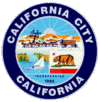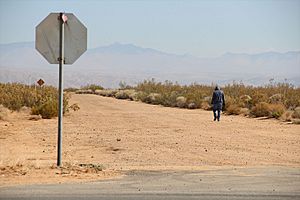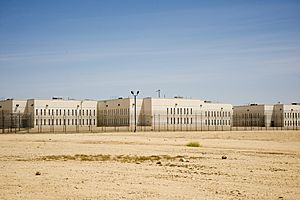California City, California facts for kids
Quick facts for kids
California City, California
|
|||
|---|---|---|---|
| City of California City | |||
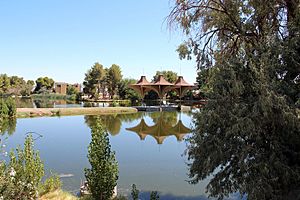
West Side of California City Central Park
|
|||
|
|||
| Nickname(s):
Cal City
|
|||
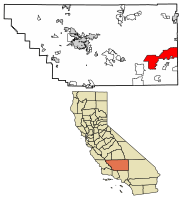
Location of California City in Kern County, California.
|
|||
| Country | |||
| State | |||
| County | Kern | ||
| Incorporated | December 10, 1965 | ||
| Named for | California | ||
| Area | |||
| • Total | 203.70 sq mi (527.57 km2) | ||
| • Land | 203.61 sq mi (527.35 km2) | ||
| • Water | 0.09 sq mi (0.22 km2) 0.04% | ||
| Elevation | 2,405 ft (733 m) | ||
| Population
(2020)
|
|||
| • Total | 14,973 | ||
| • Density | 73.54/sq mi (28.39/km2) | ||
| Time zone | UTC−08:00 (PST) | ||
| • Summer (DST) | UTC−07:00 (PDT) | ||
| ZIP Codes |
93504-93505
|
||
| Area codes | 442/760 and 661 | ||
| FIPS code | 06-09780 | ||
| GNIS feature IDs | 1660418, 2409960 | ||
California City is a city in Kern County, California, United States. It is located in the northern part of the Antelope Valley. The city is about 100 miles (160 km) north of Los Angeles. In 2020, about 14,973 people lived there.
California City is very large in terms of land area. It covers about 203.63 square miles (527.4 km2). This makes it the third-largest city in California by land area. Only San Diego and Los Angeles are bigger. It is also the 43rd-largest city in the entire United States by land area.
Many people in California City work at Edwards Air Force Base. This base is about 18 miles (29 km) southeast of the city. Other big employers include the California City Correctional Center. The Mojave Air and Space Port and the Hyundai/Kia Proving Grounds also provide many jobs. California City has a park, a PGA golf course, and its own airport.
Contents
History of California City
Early Beginnings
Before the 1960s, the area where California City is now was mostly empty. In 1776, a missionary named Padre Francisco Garcés camped near Castle Butte. This was during an expedition through what is now California and Arizona.
Later, in the late 1800s, the Twenty Mule Team Trail passed through this area. This trail was used to carry borax from mines to the train station in Mojave.
How the City Was Planned
California City started in 1958. A real estate developer and professor named Nat Mendelsohn bought 80,000 acres (320 km2) of Mojave Desert land. He wanted to plan and build California's next big city. He hoped it would one day be as big as Los Angeles.
He designed the city around a Central Park with a 26-acre (11 ha) artificial lake. However, the city did not grow as much as he expected. Today, you can see many paved roads that were meant for future neighborhoods. These roads stretch far beyond the developed parts of the city. This shows how big the original plan was. California City officially became a city on December 10, 1965.
Even though it didn't grow as planned, California City has still grown a lot. The population increased from 3,200 people in 1985 to over 14,000 in 2009. Cerro Coso Community College even bought land for a new college campus. This campus serves students from California City, Edwards Air Force Base, and nearby towns. The first post office in the city opened in 1960.
Geography and Climate
City Area
California City covers a total area of about 203.6 square miles (527.3 km2). Only a tiny part, about 0.1 square miles (0.26 km2), is water. As mentioned, it's the third-largest city in California by land area.
Weather in California City
| Climate data for California City, CA | |||||||||||||
|---|---|---|---|---|---|---|---|---|---|---|---|---|---|
| Month | Jan | Feb | Mar | Apr | May | Jun | Jul | Aug | Sep | Oct | Nov | Dec | Year |
| Mean daily maximum °F (°C) | 58 (14) |
62 (17) |
66 (19) |
72 (22) |
81 (27) |
91 (33) |
97 (36) |
96 (36) |
90 (32) |
79 (26) |
66 (19) |
58 (14) |
76 (25) |
| Mean daily minimum °F (°C) | 34 (1) |
37 (3) |
41 (5) |
46 (8) |
54 (12) |
62 (17) |
67 (19) |
66 (19) |
59 (15) |
49 (9) |
39 (4) |
33 (1) |
49 (9) |
| Average precipitation inches (mm) | 1.34 (34) |
1.51 (38) |
1.13 (29) |
0.22 (5.6) |
0.15 (3.8) |
0.05 (1.3) |
0.16 (4.1) |
0.27 (6.9) |
0.28 (7.1) |
0.28 (7.1) |
0.43 (11) |
0.81 (21) |
6.63 (168.9) |
| Source: The Weather Channel | |||||||||||||
People of California City
| Historical population | |||
|---|---|---|---|
| Census | Pop. | %± | |
| 1970 | 1,309 | — | |
| 1980 | 2,743 | 109.5% | |
| 1990 | 5,955 | 117.1% | |
| 2000 | 8,385 | 40.8% | |
| 2010 | 14,120 | 68.4% | |
| 2020 | 14,973 | 6.0% | |
| U.S. Decennial Census | |||
California City has grown steadily over the years. In 2000, there were 8,385 people living in the city. By 2020, the population had grown to 14,973. This shows that more and more people are choosing to live in California City.
The city is home to a diverse group of people. In 2010, about 65.1% of residents were White, 15.2% were African American, and 2.6% were Asian. About 38.1% of the population was Hispanic or Latino.
The average age in California City in 2010 was about 34.8 years old. Many households had children under 18 living with them. The city's population has continued to increase, making it one of the faster-growing cities in the region.
Economy and Jobs
One important part of California City's economy was the California City Correctional Facility. This prison was built in 1999. It housed federal inmates for many years. Later, the state of California leased it to help with prison overcrowding. However, the state ended its lease, and the prison closed in March 2024.
Another major employer in the city is the Hyundai-Kia proving grounds. This is a large testing area for cars. It covers about 3,967 acres (16 km2) within the city limits.
Sports
California City once had a professional baseball team called the California City Whiptails. They played in the Pecos League. The team played their home games at Balsitis Park. However, the team stopped playing in 2019.
Education
The Mojave Unified School District serves the students of California City. Here are some of the schools in the city:
- California City Jr/Sr High
- California City Middle
- Hacienda Elementary School
- Robert P. Ulrich Elementary School (opened in 1966)
Getting Around (Transportation)
California City is connected to other areas by major roads. Highway 14 is to the west, and Highway 58 is to the south.
For public transportation, Kern Transit offers bus services. You can take a bus directly to Mojave, Lancaster, and Ridgecrest. From these places, you can connect to other cities like Tehachapi and Bakersfield. The Kern Transit 250 bus to Lancaster connects with Metrolink trains. These trains can take you to the San Fernando Valley and Los Angeles.
Within California City, there is a service called California City Dial-A-Ride (DAR) Transit. This service provides rides on weekdays when you call and ask for one.
See also
 In Spanish: California City para niños
In Spanish: California City para niños



